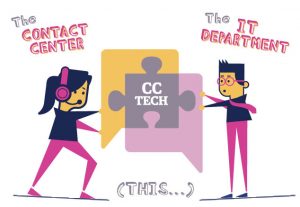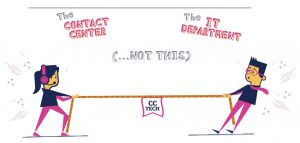Working Together To Optimize Technology
“A stalemate can occur when the center wants IT to educate them on what’s possible and IT wants the center to define what they want or need.”

and President of
Strategic Contact.
Technology is the great enabler but too often falls short in delivering promised results, leaving users and executives frustrated. Whether pursuing exciting new technology or refreshing existing systems, IT and the contact center need to work together to deliver better outcomes. This article offers some impactful little changes that can help you get more for your time and money.
The Contact Center Is Evolving
Contact centers are maturing in their operational requirements and sophistication, as evidenced on a few fronts. Siloed multichannel, multimedia offerings are giving way to the quest for seamless, integrated, omnichannel service delivery. Managers are placing increased focus on performance management and the corresponding use of tools, along with aggressive pursuit of better desktop applications and knowledge sources. They recognize the importance of these technologies to help them get smarter about meeting customer expectations while increasing frontline productivity and revenue protection or generation. Forward-thinking companies also deploy improved Web and mobile apps for customers and desktop and mobile apps for agents and supervisors.
 While leaders have pretty good “wish lists” of things they want for their centers, IT is often too darn busy to tackle these initiatives. Fortunately, technology has become more user-friendly on both the administrative and configuration fronts. Leaders are increasingly ready, willing and able to take on more contact center technology responsibility. Their enthusiasm may be fueled by the belief that they could solve their operational challenges and capitalize on opportunities if only they could get their hands on the latest tools.
While leaders have pretty good “wish lists” of things they want for their centers, IT is often too darn busy to tackle these initiatives. Fortunately, technology has become more user-friendly on both the administrative and configuration fronts. Leaders are increasingly ready, willing and able to take on more contact center technology responsibility. Their enthusiasm may be fueled by the belief that they could solve their operational challenges and capitalize on opportunities if only they could get their hands on the latest tools.
While the right technology may be a necessary condition to shore up known deficiencies, the No. 1 factor holding centers back may well be lack of dedicated support resources. Technology implementation must be paired with effective project management, change management and vendor management to create a successful launch. Then, centers must invest in analytical and administrative skills to optimize technology use and provide actionable feedback to the organization. Transformation cannot occur when implementation and ongoing support are relegated to “spare-time” efforts.
IT Is in Transition
IT is in a state of flux due to changes in technology, internal resources (numbers and/or expertise) and user demands. We’ve seen two primary responses to this transition:
1. IT TRYING TO MANAGE ALL TECHNOLOGY—BUT NOT ALWAYS HANGING ON.
In this case, IT is still managing their own systems, networks and data centers, either because it is a core competency or viewed as mission-critical, or both. They want to manage contact center technology as well and may be reluctant to relinquish control of an area they traditionally owned. However, some are now seeing the opportunity to peel off contact center technology as a function of losing specialized expertise and/or the desire to maintain it. In these cases, contact center technology is no longer a top IT priority, and many other things can overshadow it—from projects to firefighting to the latest hot topic, such as fraud, of late.
2. IT MOVING AWAY FROM TECHNOLOGY RESPONSIBILITIES NOT CENTRAL TO THEIR BUSINESS.
This model may be catalyzed by cloud solutions across many application areas, along with those simpler user interfaces that don’t require a programmer. IT departments must make choices when faced with the reality of too few people to support too many tasks. They have growing responsibilities in core systems, networks and data tied to compliance, security/fraud protection, BC/DR and more. They also need to have more knowledge systems, customer data and enhanced applications to be competitive and support business needs. They declare they “don’t want to be in the data center business” and are OK with cloud contact center technology and the center doing more as long as it meets their security, reliability, BC/DR and architecture needs and doesn’t jeopardize other elements of IT infrastructure and applications.
 In either case, a stalemate can occur when the center wants IT to educate them on what’s possible and IT wants the center to define what they want or need. If all IT hears is “I want xxx,” the lack of clarity can push the request down the list of competing priorities. While the center may be willing to assume greater responsibility for their technology going forward, IT needs to engage at some level. The center can’t go it alone, even with cloud solutions.
In either case, a stalemate can occur when the center wants IT to educate them on what’s possible and IT wants the center to define what they want or need. If all IT hears is “I want xxx,” the lack of clarity can push the request down the list of competing priorities. While the center may be willing to assume greater responsibility for their technology going forward, IT needs to engage at some level. The center can’t go it alone, even with cloud solutions.
Typically, it is easier to get IT attention on something new. After all, new technology is exciting, and most companies have some structure for pursuing them. But what if existing stuff simply needs a “refresh”? Such efforts are unlikely to gain traction unless centers do a good job defining their projects, identifying the benefits to be reaped, and specifying the level of engagement they’ll need from IT.
If you’re lucky enough (and probably big and sophisticated enough) to have IT people focused on contact center technology, count your blessings! Leverage them to the best of your ability! If you don’t, you’ll need to realistically assess IT skills and bandwidth (including their focus or lack thereof on the contact center) and address technology planning and pursuit accordingly. If IT wants to control contact center technology but doesn’t have the resources to do it, it’s time to assess the impact and move the conversation up the chain of command.
Top Tips for Technology Optimization
Here are our top tips for optimizing new or existing technology to the benefit of the contact center and IT in whatever positions they find themselves.
MAKE SURE ROLES AND RESPONSIBILITIES ARE CLEAR
The contact center, IT, vendors and value-added resellers (VARs) are all critical players in contact center technology success. Roles and responsibilities run the gamut from configuration, administration and day-to-day changes to optimization based on root-cause analysis, trending and new business needs. The “owner” of strategic planning needs to be clearly identified. It may be IT for architecture and technology demands (e.g., compliance, security, BC/DR) and the center for new business needs (e.g., growth, new offerings, changes in sites, etc.). All parties need to respect one another’s roles and work together to the best of their abilities. IT and the contact center need clear and consistent rules for knowing when to involve the vendor versus handle matters internally—whether for troubleshooting, “fix,” configuration, gap closure, etc. And when it comes to monitoring the health and performance of the systems, you may need to look to the vendor or VAR first, especially for cloud solutions. Keep in mind: The vendor team includes more than just talking to support. There are times when you may need to reengage an account manager or sales engineer.
CLEARLY DEFINE REQUIREMENTS
Requirements definition is primarily a CC burden and is an obvious need for new technology (e.g., writing an RFP). It is also important for existing technology—to make the most out of what you have, do the next thing, use the things you have in better ways, and solve real problems. Think of each effort in terms of a project lifecycle—define, plan, implement and support. Identify issues and options to address them, documenting what is needed from a functional perspective, performance improvement, etc. Close gaps by doing new things, or doing things differently. Combine what’s possible with what you need to do.
Your Technology Improvement Checklist
Here is a visual “checklist” of some important things to do to
work together to optimize contact center technology
:: Have dedicated, properly skilled and trained analyst(s).
:: Encourage routine observations of contact handling by key IT staff.
:: Secure agent engagement in improvement opportunities and close the loop.
:: Develop and document requirements for new needs, gaps to fill and issues to resolve.
:: Define SLAs between IT and the CC for critical services, just as you would with a vendor.
:: Formalize contact center technology education with an ongoing learning and development plan.
CROSS-POLLINATE AND EDUCATE
Make a commitment to leverage each other’s core competencies. The center needs to articulate clearly what it needs to address problems or opportunities, and IT can and should help the CC understand what’s possible and the pros and cons of alternative approaches. Of course, contact center conferences, webinars, articles, white papers and eBooks are good (and plentiful) sources of information. You also need to look beyond those industry sources to targeted discussions about your environment.
Focus on what your center needs to improve operations, not just what looks new and exciting.
Vendor meetings can dive into functionality, architecture and technology issues, including security and resiliency. They can cover sourcing strategies and their implications for implementation and support. Ideally, a quarterly or biannual routine with your established suppliers does the trick, augmented with ad hoc meetings when something new or different triggers it (whether market changes, business needs or technology issues). Many vendors welcome such meetings, but it is rarely done routinely. Therefore, assign roles and responsibilities for making it happen—e.g., vendor sales rep, CC or IT—or schedule the next session at the conclusion of the current one.
A caution is in order here though to avoid the “shiny objects” syndrome. Make sure that you focus on what your center needs to improve operations, not just what looks new and exciting.
USE CC REPORTS AND DATA, ALONG WITH AGENT INPUT
Use your mountains of contact center reports and data to identify technology opportunities. For example, performance metrics such as time in IVR (without resolution or proper routing), high transfer rates, high or increasing handle times, low FCR or inconsistencies in key performance indicators can reveal pain points and opportunities to improve. IT or vendors may also have data on performance of systems or networks (e.g., uptime, response time).
An invaluable source of insights sits there using your technology all day, every day—agents. Ask for input, ideas and suggestions. Make sure that you have a clear, ongoing process to solicit feedback and communicate how you will use the data (this assures them their input is valued!). Weed out anecdotes, and separate process issues from system issues. Publish lists with priorities based on biggest need and highest value and impact. Close the loop on actions to avoid the cynicism-inducing “black holes” typical of these programs. Show what makes it to the “to do” list (and why), what is in evaluation, what is put onto future roadmap plans, what can’t be done (and why), and any compromises or alternatives being pursued to address the issue.
Issues revealed in these processes are often about integration, or using data or systems in better ways—not just new stuff. They will undoubtedly highlight the importance of the CC and IT working together, and the role of an analyst with the right training and skills. Data and input do not mean much without the analysis to identify opportunities and gaps and develop recommendations to address them. An analyst who enjoys agent respect and works well with CC leadership, IT, and vendors is not necessarily easy to find. But they can be invaluable in finding ways to optimize the center and the enabling technology.
WITH EXISTING TECHNOLOGY—ASSESS, PLAN AND IMPROVE
Develop an institutional process to focus on in-place systems to assess, plan and improve them. Centers that identify issues, review
options, and make plans to address them every six or 12 months get more out of their technology than ones that declare projects “done” and move on, never looking back. These reviews can and should be coordinated with the periodic vendor management meetings noted earlier. They can lead to changes to how the technology is used, plans for the next phase or function to add, or adjustments to processes, roles or responsibilities.
WHEN PURSUING NEW TECHNOLOGY—DEFINE AND DESIGN ANEW, THEN OPTIMIZE
Requirements documentation comes naturally when a shiny new technology is in play. It gets a lot of attention and resources (CC, IT, vendor) until the realities of time and resource pressure intervene. The path of least resistance—for you and the vendor—is to implement the new solution to look like the current one, with great intentions to do more later. Unfortunately, that shortcut compromises the whole purpose of new technology.
The right approach is to design for business value—not just replicate the same old processes and configuration. Define phases and stick with the plan. Do early checkup and optimization, for example, 90 days after cutover, when you are really getting to know the new technology. Revisit again six to 12 months later for more optimization and the next phase or functionality to make your center even better.
Everyone Can Do Better and Benefit
Contact center leaders and IT, along with the vendors, play a collective role in optimizing technology. When they work together in pursuit of common goals, they drive greater value from existing technology or new solutions and ensure that each solution delivers on its promises.
Lori Bocklund is Founder and President of Strategic Contact.
– Reprinted with permission from Contact Center Pipeline, http://www.contactcenterpipeline.com




